I don't have much time for blogging these days, but here are some interesting news items:
The AP and Inside Higher Ed are studying a new Virginia law that requires public colleges and universities to run their list of student names by the State Police to see if any of them are convicted sex offenders.
Redstate reports on the prospects of action in the near future on the nominations of Jim Haynes and Terrence Boyle to the Fourth Circuit.
The Richmond paper reports on the guilty plea of a Virginia lawyer charged with selling marijuana.
The Williamsburg paper has the story of two gentlemen who discovered that tattoo parlors are not a permitted use anywhere in James City County, so they filed suit in state court.
MSNsportsNet reports that Marshall and West Virginia will play in the "Friends of Coal" Bowl, sponsored by the West Virginia Coal Association.
Thursday, June 22, 2006
Sunday, June 18, 2006
The travelogue ends in Rome
I didn't realize how touristy Florence would be, but I had no illusions about Rome. We stayed another three days in Rome after the end of the Tuscany and Umbria tour and we went to see the most touristy tourist places that we could find. We went to the Pantheon, the Trevi fountain, the Spanish steps, the Vatican museum, Sistine Chapel, St. Peter's, St. John the Lateran and other churches, the market at Campo di Fiori, the site of the Bocca della Verita, the Castel Sant Angelo, some catacombs near the Via Appia, and what was said to be the twenty-some steps Jesus walked up to see Pontius Pilate. We saw the Circus Maximus and even the rose garden across from it. The weather was ok on the first day, blazing hot the second day, and too cold on the third day. We took one afternoon off and lounged by the pool, which was the best feature of the Sheraton Roma. We took a number of heart-stopping cab rides. We saw peace demonstrators and even more police with machine guns, and stood with crowd waiting for some unknown celebrity to exit a government building. The best place we ate was a restaurant called Sabatini in the Piazza di Santa Maria in Trastevere.
Here are some pictures:
Fountain in the Piazza Navona
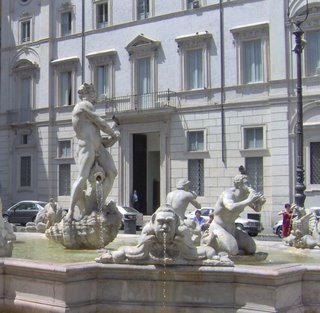
The Pantheon

The Trevi fountain
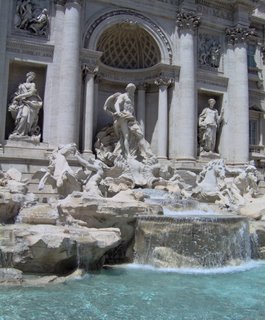
The Spanish Steps

Santa Maria Maggiore

Vatican Museum

Santa Maria di Trastevere
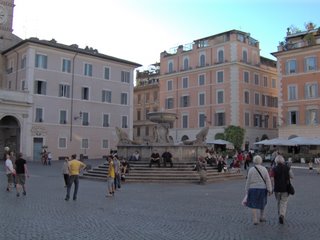
Campo di Fiori

Across the street from the Circus Maximus and the Forum ruins

Inside St. Peter's

Outside St. Peter's
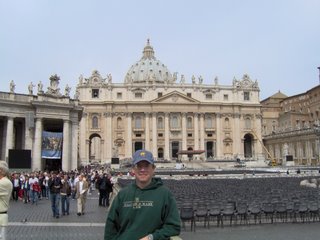
Along the Tiber, looking back at St. Peter's and the Castel Sant Angelo
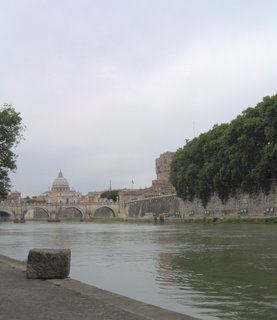
Last lunch, again in the Piazza Navona

Here are some pictures:
Fountain in the Piazza Navona

The Pantheon

The Trevi fountain

The Spanish Steps

Santa Maria Maggiore

Vatican Museum

Santa Maria di Trastevere

Campo di Fiori

Across the street from the Circus Maximus and the Forum ruins

Inside St. Peter's

Outside St. Peter's

Along the Tiber, looking back at St. Peter's and the Castel Sant Angelo

Last lunch, again in the Piazza Navona

Cortona - Perugia - Spoleto - Assisi
 After the mean streets of Florence, our return to the countryside was something of a relief. As the tour progressed, the guide Genevieve did less talking and instead would play music or do something else as we moved from one town to another. She played a video about the Palio as we left Siena. One day she played music from Life is Beautiful, another day Puccini, the last day a medley of Italian folk songs. As we left Florence, however, she read (in English) a couple of stories from the original Pinocchio, which had a tranquilizing effect as we left the city and went back into the country to Cortona. Cortona is lately famous as the setting for Under the Tuscan Sun, the movie and the novel. Looking down into the valley, however, one can see the edge of lake which was the setting for the Battle of Lake Trasimene, fought between the Romans and the Carthaginians in 217 B.C. We arrived in Cortona on a Saturday, which was the market day, and so there was shopping. After a few hours in the town, we down into the valley to a cooking school, where the chef was the mother and the translator was her son. Eating followed the learning, and the food was excellent.
After the mean streets of Florence, our return to the countryside was something of a relief. As the tour progressed, the guide Genevieve did less talking and instead would play music or do something else as we moved from one town to another. She played a video about the Palio as we left Siena. One day she played music from Life is Beautiful, another day Puccini, the last day a medley of Italian folk songs. As we left Florence, however, she read (in English) a couple of stories from the original Pinocchio, which had a tranquilizing effect as we left the city and went back into the country to Cortona. Cortona is lately famous as the setting for Under the Tuscan Sun, the movie and the novel. Looking down into the valley, however, one can see the edge of lake which was the setting for the Battle of Lake Trasimene, fought between the Romans and the Carthaginians in 217 B.C. We arrived in Cortona on a Saturday, which was the market day, and so there was shopping. After a few hours in the town, we down into the valley to a cooking school, where the chef was the mother and the translator was her son. Eating followed the learning, and the food was excellent. The day in Cortona got only two pages in my travel journal, which indicates primarily that there was nothing but fun. If you check the Wikipedia page for Cortona, you see this picture of an Andre Rieu concert. When we were there, the pace in the Piazza Della Republica was sedate and agreeable. A vendor was selling sandwiches of roast pig, called porchetta. In the food shops, the clerks gave away lots of samples, of olive oil and cheese and wine, and made many sales. Dana bought some black truffle oil. I ate dishes with black truffle at every opportunity while we were in Perugia. The only obvious tourists were the people in our group. There were no cars moving the whole time I was there.
The day in Cortona got only two pages in my travel journal, which indicates primarily that there was nothing but fun. If you check the Wikipedia page for Cortona, you see this picture of an Andre Rieu concert. When we were there, the pace in the Piazza Della Republica was sedate and agreeable. A vendor was selling sandwiches of roast pig, called porchetta. In the food shops, the clerks gave away lots of samples, of olive oil and cheese and wine, and made many sales. Dana bought some black truffle oil. I ate dishes with black truffle at every opportunity while we were in Perugia. The only obvious tourists were the people in our group. There were no cars moving the whole time I was there. We stayed the next three nights in Perugia, in a room with a little balcony. The hotel in Perugia was the most enjoyable of the places where we stayed, as it had a terrace on the third floor, and we were invited into the kitchen where the chef made chocolate desserts for us. The day after Cortona, we went to Spoleto and Assisi. On the way back from Assisi, we saw an airshow by a group of fighter pilots from the Italian Air Force, the Frecce Tricolori. People were stopped by the road, standing on their cars, standing out in fields, and standing on their houses to see the jets. One fellow was sitting on top of his chimney. The jets flew back and forth over the bus as we inched through the traffic back to Perugia. You can see slides of the May 28 airshow over Perugia here. Later on our last day in Rome on June 2, which was the national holiday celebrating the anniversary of the Republic, we saw the same group pass overhead as we were eating lunch in the Piazza Navona.
We stayed the next three nights in Perugia, in a room with a little balcony. The hotel in Perugia was the most enjoyable of the places where we stayed, as it had a terrace on the third floor, and we were invited into the kitchen where the chef made chocolate desserts for us. The day after Cortona, we went to Spoleto and Assisi. On the way back from Assisi, we saw an airshow by a group of fighter pilots from the Italian Air Force, the Frecce Tricolori. People were stopped by the road, standing on their cars, standing out in fields, and standing on their houses to see the jets. One fellow was sitting on top of his chimney. The jets flew back and forth over the bus as we inched through the traffic back to Perugia. You can see slides of the May 28 airshow over Perugia here. Later on our last day in Rome on June 2, which was the national holiday celebrating the anniversary of the Republic, we saw the same group pass overhead as we were eating lunch in the Piazza Navona. The day after Cortona, we went to Spoleto and Assisi. We entered Spoleto by way of the famous medieval bridge, the Ponte delle Tori, and worked our way down past the cathedral and we were picked up below the town a few hours later. Spoleto has got much more going on than the small towns we visited, but it was Sunday when we were there and so I couldn't guess how much busier it is when everyone is working. The shops were open, nevertheless, and there were many good places to eat. The best pizza we had on the trip, or that which best hit the spot, was in Spoleto. The pizza we had in Italy should have been called something else, as it was quite unlike the pizza I eat in the United States, all of it had a thin and crispy crust and the toppings were more simple and less of them. It was tasty but never dripping with cheese and sauce. And, "pepperoni" does not mean "pepperoni" in Italian. We sometimes had prosciutto on the pizzas but that was the only meat we ordered. Most often we had tomato, cheese, and mushroom pizzas, as simple as it sounds.
The day after Cortona, we went to Spoleto and Assisi. We entered Spoleto by way of the famous medieval bridge, the Ponte delle Tori, and worked our way down past the cathedral and we were picked up below the town a few hours later. Spoleto has got much more going on than the small towns we visited, but it was Sunday when we were there and so I couldn't guess how much busier it is when everyone is working. The shops were open, nevertheless, and there were many good places to eat. The best pizza we had on the trip, or that which best hit the spot, was in Spoleto. The pizza we had in Italy should have been called something else, as it was quite unlike the pizza I eat in the United States, all of it had a thin and crispy crust and the toppings were more simple and less of them. It was tasty but never dripping with cheese and sauce. And, "pepperoni" does not mean "pepperoni" in Italian. We sometimes had prosciutto on the pizzas but that was the only meat we ordered. Most often we had tomato, cheese, and mushroom pizzas, as simple as it sounds. We figured out the menus as we went along. When we got back, the girl across the street asked if we had an Italian phrase book. I laughed and said all the Italian we used would fit on a single page. Always and everywhere I said "grazie" to the waiters (who replied "prego"), "buon giorno" and "bona sera" when I saw members of our group out and about, and "andiamo" we were running late. The whole time, my father-in-law believed that he had mastered the phrase, "il conto, por favor." (Perhaps the waiters thought he was half-Spanish.) The gelato places often had labels in English, but we tried interesting looking flavors based as much on what they looked like as what they were. At some restaurants we ordered pasta or what not based more on the sauce than the noodle - we learned a few ingredients and would order something flavored with what we liked, but there was always some guesswork. The only television I watched for more than a minute in Italian was one of the Naked Gun movies, with Frank Drebbin speaking Italian (and it was the one in which he impersonates Enrico Palazzo). And so it was that I had to ponder the significance of a cafe in Spoleto with the letters "UVA" on the glass - either the place had some connection with the Italian word for "grape" or it was some kind of Wahoo alumni extension office previously unknown to me.
We figured out the menus as we went along. When we got back, the girl across the street asked if we had an Italian phrase book. I laughed and said all the Italian we used would fit on a single page. Always and everywhere I said "grazie" to the waiters (who replied "prego"), "buon giorno" and "bona sera" when I saw members of our group out and about, and "andiamo" we were running late. The whole time, my father-in-law believed that he had mastered the phrase, "il conto, por favor." (Perhaps the waiters thought he was half-Spanish.) The gelato places often had labels in English, but we tried interesting looking flavors based as much on what they looked like as what they were. At some restaurants we ordered pasta or what not based more on the sauce than the noodle - we learned a few ingredients and would order something flavored with what we liked, but there was always some guesswork. The only television I watched for more than a minute in Italian was one of the Naked Gun movies, with Frank Drebbin speaking Italian (and it was the one in which he impersonates Enrico Palazzo). And so it was that I had to ponder the significance of a cafe in Spoleto with the letters "UVA" on the glass - either the place had some connection with the Italian word for "grape" or it was some kind of Wahoo alumni extension office previously unknown to me. In Spoleto, we snuck a peak at the Roman ampitheatre. Umbria being closer to Rome, were told that it was more greatly influenced by Imperial Rome. In each place we went, the guides tried to say something of the history, including the influence of the Etruscans, the Roman Empire, and in Umbria, the tribe of the Umbri. I was informed, perhaps erroneously, that outdoor performances related to the famous Spoleto festival are held in the ampitheatre and also in the piazza in front of the cathedral. It is hard to imagine this scene. When we went to the cathedral, no one was there. It seemed odd to be touring a church, any church, but we went to many before we were done. The various guides at different points repeated the fact that church attendance is on the wane in Italy. As we were leaving the cathedral, we met a few townspeople on their way in to the 11:00 mass.
In Spoleto, we snuck a peak at the Roman ampitheatre. Umbria being closer to Rome, were told that it was more greatly influenced by Imperial Rome. In each place we went, the guides tried to say something of the history, including the influence of the Etruscans, the Roman Empire, and in Umbria, the tribe of the Umbri. I was informed, perhaps erroneously, that outdoor performances related to the famous Spoleto festival are held in the ampitheatre and also in the piazza in front of the cathedral. It is hard to imagine this scene. When we went to the cathedral, no one was there. It seemed odd to be touring a church, any church, but we went to many before we were done. The various guides at different points repeated the fact that church attendance is on the wane in Italy. As we were leaving the cathedral, we met a few townspeople on their way in to the 11:00 mass. This picture shows what the piazza looked like as we saw it on Sunday morning. There were no crowds in Spoleto. The local guide explained the complicated history of the cathedral and the town. At several points, the local guides in Spoleto and elsewhere were somewhat anti-clerical in their commentary. We were told of the pasta called "strangolapreti," which means something like "priest choker," and the explanation was that the noodles were so thick that only the rich priests could afford them, and the poor people hoped they choked on them. We were told more than once that the Pane Toscano has no salt as a protest against a salt tax imposed by the Church. We were told that the Church retaliated against the towns for their rebellion. The Church was blamed, for example, for the removal of the medieval towers from the towns that tried to break with the Church.
This picture shows what the piazza looked like as we saw it on Sunday morning. There were no crowds in Spoleto. The local guide explained the complicated history of the cathedral and the town. At several points, the local guides in Spoleto and elsewhere were somewhat anti-clerical in their commentary. We were told of the pasta called "strangolapreti," which means something like "priest choker," and the explanation was that the noodles were so thick that only the rich priests could afford them, and the poor people hoped they choked on them. We were told more than once that the Pane Toscano has no salt as a protest against a salt tax imposed by the Church. We were told that the Church retaliated against the towns for their rebellion. The Church was blamed, for example, for the removal of the medieval towers from the towns that tried to break with the Church. From Spoleto, we went on to Assisi, where we toured the lower church, the upper church, the upper town, and the lower town. Here you can see the lower entrance to the left and the upper entrance to the right. The guide was not allowed to go inside the church, perhaps the Franciscans had heard what he was telling the tourists in Spoleto and Perugia. The church was interesting but dark. In part, the art told the story of the life of St. Francis. The Franciscans were strict on keeping silence in the lower church. The noise was policed by an amplified voice demanding "Silencio!" every few minutes. The story of St. Francis is compelling, the churches were interesting, and the lower town was very nice, so I enjoyed Assisi, even though it was unseasonably hot. Inevitably, many of the small shops we saw in these hilltop towns have their own websites, including this one from Assisi.
From Spoleto, we went on to Assisi, where we toured the lower church, the upper church, the upper town, and the lower town. Here you can see the lower entrance to the left and the upper entrance to the right. The guide was not allowed to go inside the church, perhaps the Franciscans had heard what he was telling the tourists in Spoleto and Perugia. The church was interesting but dark. In part, the art told the story of the life of St. Francis. The Franciscans were strict on keeping silence in the lower church. The noise was policed by an amplified voice demanding "Silencio!" every few minutes. The story of St. Francis is compelling, the churches were interesting, and the lower town was very nice, so I enjoyed Assisi, even though it was unseasonably hot. Inevitably, many of the small shops we saw in these hilltop towns have their own websites, including this one from Assisi. Here you can see a little bit of what the lower part of the town was like, with shops wedged into the buildings but also the view of the valley below. After walking through Spoleto and Assisi, we were tired when we got back to Perugia, and so we ate at a place called La Taverna, which was another good place, even though walking down there did not look promising from up on the main drag. Perugia is by no means a small town but it is not really a tourist town, either, and so we enjoyed it, and it had views in every direction. Our last day of the organized tour required no bus trip as we simply walked out of the hotel and toured a little bit of Perugia. Almost every place we went, we were told told that the town has a symbol or sometimes more than one. In Siena, they claim a connection with the wolf. In Perugia, it was the griffin.
Here you can see a little bit of what the lower part of the town was like, with shops wedged into the buildings but also the view of the valley below. After walking through Spoleto and Assisi, we were tired when we got back to Perugia, and so we ate at a place called La Taverna, which was another good place, even though walking down there did not look promising from up on the main drag. Perugia is by no means a small town but it is not really a tourist town, either, and so we enjoyed it, and it had views in every direction. Our last day of the organized tour required no bus trip as we simply walked out of the hotel and toured a little bit of Perugia. Almost every place we went, we were told told that the town has a symbol or sometimes more than one. In Siena, they claim a connection with the wolf. In Perugia, it was the griffin. Here is a view from an outdoor place where we went to sit and cool off after the walking in Spoleto and Assisi. We did a lot of walking also in Perugia, during the three days we were there. The first night the main street was filled with thousands of teenagers. It was Saturday night. We were told that the thing to do in Perugia (and elsewhere) is to take a passeggiata. We generally didn't. We were overwalked and overfed. What walking we did at night was mainly walking back from dinner. The restaurants mainly do not open for dinner until around 7:30, which seemed plenty late. We were told that the midday meal is the main meal for Italians, but no one seems to have shared that information with the people who were selling the food to the Americans at night.
Here is a view from an outdoor place where we went to sit and cool off after the walking in Spoleto and Assisi. We did a lot of walking also in Perugia, during the three days we were there. The first night the main street was filled with thousands of teenagers. It was Saturday night. We were told that the thing to do in Perugia (and elsewhere) is to take a passeggiata. We generally didn't. We were overwalked and overfed. What walking we did at night was mainly walking back from dinner. The restaurants mainly do not open for dinner until around 7:30, which seemed plenty late. We were told that the midday meal is the main meal for Italians, but no one seems to have shared that information with the people who were selling the food to the Americans at night. The historic center of Perugia is sort of hilltop pedestrian mall, where the main items of interest are the town hall, the fountain, and the cathedral. This picture was taken from the steps of the church looking across to the town hall, where you can see griffins above the door. The other most famous fact about Perugia is that it is where Perugina chocolate, or some of it, is made. Perugina is now owned by Nestle, but we were told that all of the Baci are made in Perugia. Perugia is held out as the chocolate capital much in the same way that Hershey, PA, claims to be a chocolate capital. We were told that the original name for the Baci was "The Knuckle" but some sharp marketer concluded that a better name would be "The Kiss." (I bought a small sack of the little ones for the people at the office, the cheapskate that I am.)
The historic center of Perugia is sort of hilltop pedestrian mall, where the main items of interest are the town hall, the fountain, and the cathedral. This picture was taken from the steps of the church looking across to the town hall, where you can see griffins above the door. The other most famous fact about Perugia is that it is where Perugina chocolate, or some of it, is made. Perugina is now owned by Nestle, but we were told that all of the Baci are made in Perugia. Perugia is held out as the chocolate capital much in the same way that Hershey, PA, claims to be a chocolate capital. We were told that the original name for the Baci was "The Knuckle" but some sharp marketer concluded that a better name would be "The Kiss." (I bought a small sack of the little ones for the people at the office, the cheapskate that I am.) On the last day, we wandered off the top of the hill into some of the alleys and backstreets. I'm not exactly sure where we went, but we took many pictures before choosing this promising "street" as our route back to the places we knew. We shuffled back to the hotel for the farewell dinner with the tour group. The next day we were back in Rome.
On the last day, we wandered off the top of the hill into some of the alleys and backstreets. I'm not exactly sure where we went, but we took many pictures before choosing this promising "street" as our route back to the places we knew. We shuffled back to the hotel for the farewell dinner with the tour group. The next day we were back in Rome.
Subscribe to:
Comments (Atom)